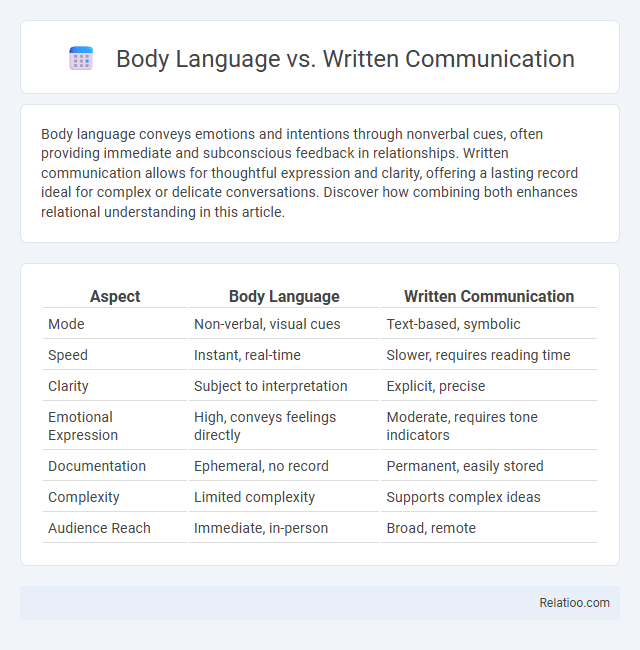Body language conveys emotions and intentions through nonverbal cues, often providing immediate and subconscious feedback in relationships. Written communication allows for thoughtful expression and clarity, offering a lasting record ideal for complex or delicate conversations. Discover how combining both enhances relational understanding in this article.
Table of Comparison
| Aspect | Body Language | Written Communication |
|---|---|---|
| Mode | Non-verbal, visual cues | Text-based, symbolic |
| Speed | Instant, real-time | Slower, requires reading time |
| Clarity | Subject to interpretation | Explicit, precise |
| Emotional Expression | High, conveys feelings directly | Moderate, requires tone indicators |
| Documentation | Ephemeral, no record | Permanent, easily stored |
| Complexity | Limited complexity | Supports complex ideas |
| Audience Reach | Immediate, in-person | Broad, remote |
Understanding Body Language: The Unspoken Dialogue
Understanding body language reveals the unspoken dialogue that complements or contradicts written communication, enhancing your ability to interpret emotions and intentions beyond words. Nonverbal cues such as facial expressions, gestures, and posture provide crucial context that written text alone often lacks, making it essential for effective interpersonal interactions. Mastering body language enables you to decode hidden messages, improving clarity and connection in both personal and professional communication.
The Essence of Written Communication
Written communication captures the essence of your message through carefully chosen words, structures, and punctuation, allowing for clarity and precision unmatched by body language. Unlike body language, which is often subconscious and open to interpretation, written communication provides a permanent, verifiable record that ensures your intent is explicitly conveyed. Mastering written communication enhances your ability to influence, inform, and connect across distances and cultures where nonverbal cues fail to translate.
Nonverbal Cues: What Your Body Says
Nonverbal cues in body language reveal emotions and intentions more transparently than written communication, often conveying feelings through gestures, facial expressions, and posture. Written communication lacks these visual signals, relying solely on word choice, tone, and punctuation to infer sentiment, which can lead to misinterpretation. Understanding body language enhances interpersonal interactions by providing context that words alone cannot express, making it a crucial element in effective communication.
Clarity and Precision in Written Messages
Written communication demands clarity and precision to ensure your message is accurately understood, minimizing misinterpretation common in body language cues. Unlike body language, which relies on nonverbal signals that can be ambiguous or culturally variable, written messages provide a permanent and reviewable record, enhancing clarity. Effective use of concise language and structured formatting further increases the precision and impact of your written communication.
Emotional Impact: Body Language vs. Text
Body language conveys emotions powerfully through facial expressions, gestures, and posture, creating an immediate and often subconscious connection that text alone cannot replicate. Written communication relies on word choice, punctuation, and tone to express feelings, but may lack the visceral impact body language provides. Your ability to interpret body language enhances emotional understanding, making in-person interactions more impactful than text-based exchanges.
Misinterpretations: Risks in Both Forms
Misinterpretations in body language often arise from cultural differences, ambiguous gestures, or inconsistent facial expressions, leading to misunderstandings and conflicts. Written communication risks misinterpretation due to lack of tone, context, or nonverbal cues, which can result in confusion or unintended offense. Both forms require careful attention to clarity and context to minimize errors and ensure effective message delivery.
Advantages of Face-to-Face Interaction
Face-to-face interaction offers the advantage of conveying nuanced body language, such as gestures, facial expressions, and eye contact, which enhances understanding and emotional connection beyond written communication. This real-time feedback loop reduces misinterpretations often seen in text-based messages, allowing immediate clarification and adaptation of responses. The combination of verbal and nonverbal cues strengthens trust and rapport, making face-to-face communication more effective for resolving conflicts and building relationships.
Strengths of Written Communication
Written communication offers precision and clarity, allowing complex ideas to be structured and revised for accuracy. It provides a permanent record that can be referenced and shared, enhancing accountability and consistency across diverse audiences. Unlike body language, written communication transcends time and space, enabling thoughtful, deliberate expression without the immediacy of face-to-face interaction.
Choosing the Right Medium: Context Matters
Choosing the right communication medium depends on the context and message complexity. Body language effectively conveys emotions and builds trust in face-to-face interactions, while written communication ensures clarity, precision, and a permanent record for detailed or formal information. Understanding the audience's needs and situational factors optimizes communication effectiveness by aligning nonverbal cues or textual clarity with the desired outcome.
Integrating Body Language with Written Communication
Integrating body language with written communication enhances the clarity and emotional impact of your messages by incorporating visual cues such as facial expressions and gestures alongside text. Utilizing video messages or synchronized multimedia presentations allows your audience to interpret tone and intent more accurately, reducing misunderstandings often associated with plain text. Combining these methods improves engagement and reinforces the message, making communication more effective across digital platforms.

Infographic: Body language vs Written communication
 relatioo.com
relatioo.com